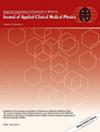Human visual perception-based grayscale contrast enhancement with adaptive window settings in computed tomography images
Abstract
Background
Grayscale contrast plays a significant role in medical imaging. This is due to the fact that visual examination, where images are represented with different gray shades on display devices, is essential in current medical applications.
Purpose
The effective contrast enhancement should have the ability to provide sufficient grayscale contrast and natural image appearance in line with human visual perception (HVP). To achieve the goal, the paper proposes a novel method for grayscale contrast improvement in computed tomography (CT) diagnostics.
Methods
A new quantitative physical metric incorporating certain human visual characteristics, termed as contrast-perceived to spatial frequency ratio (CPSFR), is presented to assess the perceptual quality of grayscale-based images. The window settings achieved by maximizing CPSFR, Window Settings Automatic, was evaluated and compared with Window Settings Preset and Window Settings Manual both of which are most used in CT diagnostics in terms of target detectability and diagnostic satisfaction. Experiments were carried out with 720 phantom images and 80 patient images. In phantom study, images were acquired with the routine body protocol at varying dose levels and assessed by four CT physicists for identifying signal-present or signal-absent. In clinical study, images with liver lesions were evaluated and rated by three radiologists with a 4-point diagnostic quality score.
Results
The phantom study indicated a statistically significant improvement with Window Settings Automatic, as compared to Window Settings Preset and Window Settings Manual (all p < 0.01) in accuracy and sensitivity for consensus readings. And the clinical study demonstrated Window Settings Automatic had the distinct advantage over other candidates (highest mean score 3.0; > 40% of all top-scoring votes).
Conclusions
The proposed method is capable of enhancing grayscale contrast in the region that really interests observers and yielding natural image appearance well suited to human visual perception to improve target detectability and diagnostic performance.


 求助内容:
求助内容: 应助结果提醒方式:
应助结果提醒方式:


